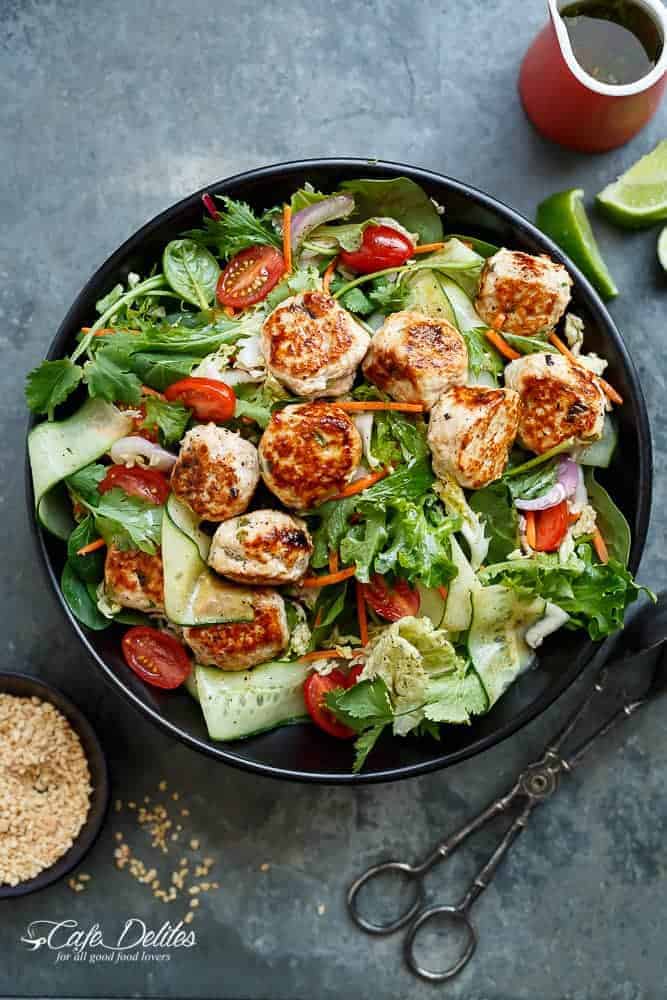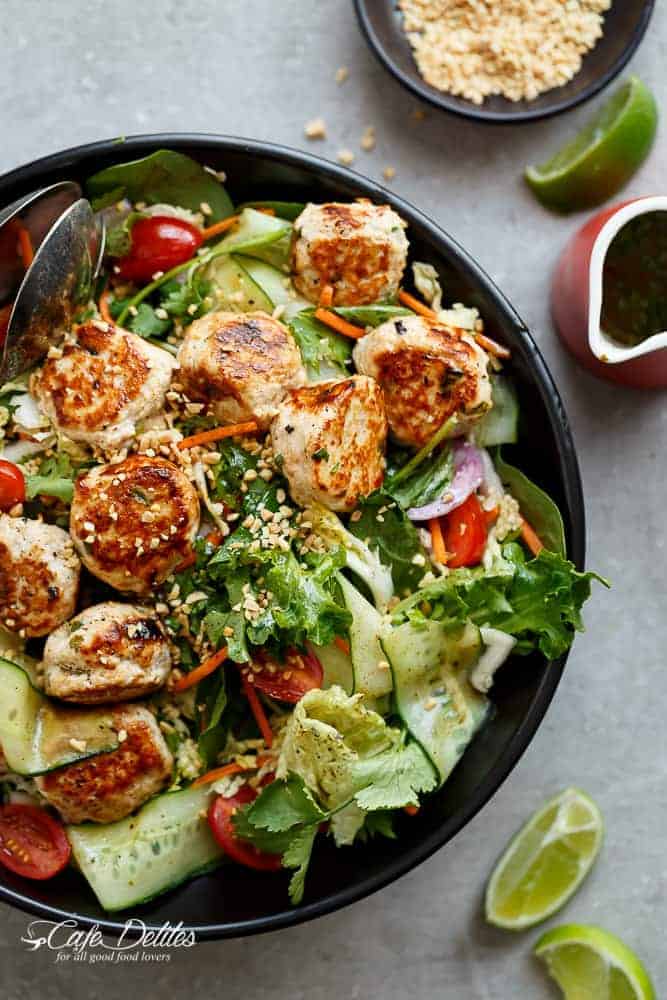Healthy diet late dinner: Chicken Meatball Salad
Chicken Meatball Salad


- 500 g lean chicken mince
- 1/4 cup breadcrumbs
- 2 tbs of any sugar-free sauce
- 2 garlic cloves large
- 1 shallot thinly sliced
- 1 tbs Thai fish sugar-free sauce
- 1 tsp minced lemon grass
- 1/2 tsp minced ginger
- 1 lime juiced
- 1/4 cup fresh coriander chopped
- 1 dash oil for frying
Salad:
- 4 cup mixed salad leaves
- 200 g cherry tomatoes halved
- 1/2 red onion thinly sliced
- 1 carrot grated
- 1 Lebanese cucumber thinly sliced
- 1/4 cup mint leaves
- 1/4 cup coriander
- parsley and coriander to garnish
Dressing:
- 1 lime juiced
- 3 tbs sesame oil
- 1 tbs Thai fish sugar-free sauce
- 1 tbs fresh coriander chopped
- 2 tsp soy sauce
- 2 tsp any sugar-free sauce
- 2 cloves garlic crushed
- 1/4 tsp minced ginger optional
- 1/4 tsp minced lemon grass optional
Method
STEP 1 In a large bowl, mix together all of the meatball ingredients until well combined.
STEP 2 Fill a shallow bowl with water; dip your hands in, shake off excess water and with wet hands, roll 1 tablespoon of meatball mixture into a ball. Repeat with remaining mixture to make 16-20 meatballs.
STEP 3 Heat a small amount of oil in a large nonstick frying pan over medium heat. Add the meatballs in batches without crowding the pan, and brown on all sides until golden and cooked through. Set aside.
STEP 4 Combine salad ingredients together in a large bowl. In a separate jug, whisk together all of the dressing ingredients and mix throughout the salad leaves.
STEP 5 Serve with the chicken meatballs and garnish with the parsley and coriander.
Notes
You can use ground ginger instead of minced ginger if preferred.
I normally use either sesame or olive oil when frying.
Use a vegetable peeler or mandolin to slice the Lebanese cucumber.
For the dressing you can use either peanut oil, olive, canola, or grapeseed oil if preferred.
Informations:
The chicken (Gallus gallus domesticus) is a type of domesticated fowl, a subspecies of the red junglefowl. It is one of the most common and widespread domestic animals, with a total population of more than 19 billion as of 2011. Humans keep chickens as a source of food, consuming both their meat and their eggs. Chickens are also kept as pets.
Genetic studies have pointed to multiple maternal origins in Southeast Asia, East Asia, and South Asia, but with the clade found in the Americas, Europe, the Middle East and Africa originating in the Indian subcontinent. From India, the domesticated chicken was imported to Lydia in western Asia Minor, and to Greece by the fifth century BC. Fowl had been known in Egypt since the mid-15th century BC, with the "bird that gives birth every day" having come to Egypt from the land between Syria and Shinar, Babylonia, according to the annals of Thutmose III.
In the UK and Ireland adult male chickens over the age of one year are primarily known as cocks, whereas in the United States, Australia and Canada they are more commonly called roosters. Males less than a year old are cockerels. Castrated roosters are called capons (surgical and chemical castration are now illegal in some parts of the world). Females over a year old are known as hens and younger females as pullets although in the egg-laying industry, a pullet becomes a hen when she begins to lay eggs at 16 to 20 weeks of age. In Australia and New Zealand (also sometimes in Britain), there is a generic term chook /ˈtʃʊk/ to describe all ages and both sexes. The young are called chicks and the meat is called chicken.
"Chicken" originally referred to young domestic fowl. The species as a whole was then called domestic fowl, or just fowl. This use of "chicken" survives in the phrase "Hen and Chickens", sometimes used as a British public house or theatre name, and to name groups of one large and many small rocks or islands in the sea (see for example Hen and Chicken Islands). The word "chicken" is sometimes erroneously construed to mean females exclusively, despite the term "hen" for females being in wide circulation.
In the Deep South of the United States chickens are also referred to by the slang term yardbird.
Chickens are omnivores. In the wild, they often scratch at the soil to search for seeds, insects and even animals as large as lizards, small snakes or young mice.
Chickens may live for five to ten years, depending on the breed. The world's oldest chicken was a hen which died of heart failure at the age of 16 according to Guinness World Records.
Roosters can usually be differentiated from hens by their striking plumage of long flowing tails and shiny, pointed feathers on their necks (hackles) and backs (saddle), which are typically of brighter, bolder colours than those of females of the same breed. However, in some breeds, such as the Sebright chicken, the rooster has only slightly pointed neck feathers, the same colour as the hen's. The identification can be made by looking at the comb, or eventually from the development of spurs on the male's legs (in a few breeds and in certain hybrids, the male and female chicks may be differentiated by colour). Adult chickens have a fleshy crest on their heads called a comb, or cockscomb, and hanging flaps of skin either side under their beaks called wattles. Collectively, these and other fleshy protuberances on the head and throat are called caruncles. Both the adult male and female have wattles and combs, but in most breeds these are more prominent in males. A muff or beard is a mutation found in several chicken breeds which causes extra feathering under the chicken's face, giving the appearance of a beard. Domestic chickens are not capable of long distance flight, although lighter birds are generally capable of flying for short distances, such as over fences or into trees (where they would naturally roost). Chickens may occasionally fly briefly to explore their surroundings, but generally do so only to flee perceived danger.
Behavior
Social behaviour
Chickens are gregarious birds and live together in flocks. They have a communal approach to the incubation of eggs and raising of young. Individual chickens in a flock will dominate others, establishing a "pecking order", with dominant individuals having priority for food access and nesting locations. Removing hens or roosters from a flock causes a temporary disruption to this social order until a new pecking order is established. Adding hens, especially younger birds, to an existing flock can lead to fighting and injury. When a rooster finds food, he may call other chickens to eat first. He does this by clucking in a high pitch as well as picking up and dropping the food. This behaviour may also be observed in mother hens to call their chicks and encourage them to eat.
A rooster's crowing is a loud and sometimes shrill call and sends a territorial signal to other roosters.[citation needed] However, roosters may also crow in response to sudden disturbances within their surroundings. Hens cluck loudly after laying an egg, and also to call their chicks. Chickens also give a low "warning call" when they sense a predator approaching.
Courtship
To initiate courting, some roosters may dance in a circle around or near a hen ("a circle dance"), often lowering the wing which is closest to the hen. The dance triggers a response in the hen and when she responds to his "call", the rooster may mount the hen and proceed with the mating.
More specifically, mating typically involves the following sequence: 1. Male approaching the hen. 2. Male pre-copulatory waltzing. 3. Male Waltzing. 4. Female crouching (receptive posture) or stepping aside or running away (if unwilling to copulate). 5. Male Mounting. 6. Male treading with both feet on hen’s back. 7. Male tail bending (following successful copulation).
Nesting and laying behaviour
Chicken eggs vary in colour depending on the hen, typically ranging from bright white to shades of brown and even blue, green, and recently reported purple (found in South Asia) (Araucana varieties).
Chicks before their first outing
Hens will often try to lay in nests that already contain eggs and have been known to move eggs from neighbouring nests into their own. The result of this behaviour is that a flock will use only a few preferred locations, rather than having a different nest for every bird. Hens will often express a preference to lay in the same location. It is not unknown for two (or more) hens to try to share the same nest at the same time. If the nest is small, or one of the hens is particularly determined, this may result in chickens trying to lay on top of each other. There is evidence that individual hens prefer to be either solitary or gregarious nesters. Some farmers use fake eggs made from plastic or stone (or golf balls) to encourage hens to lay in a particular location.
Broodiness
Under natural conditions, most birds lay only until a clutch is complete, and they will then incubate all the eggs. Many domestic hens will also do this–and are then said to "go broody". The broody hen will stop laying and instead will focus on the incubation of the eggs (a full clutch is usually about 12 eggs). She will "sit" or "set" on the nest, protesting or pecking in defense if disturbed or removed, and she will rarely leave the nest to eat, drink, or dust-bathe. While brooding, the hen maintains the nest at a constant temperature and humidity, as well as turning the eggs regularly during the first part of the incubation. To stimulate broodiness, owners may place several artificial eggs in the nest. To discourage it, they may place the hen in an elevated cage with an open wire floor.
Comments
Post a Comment